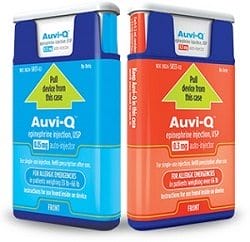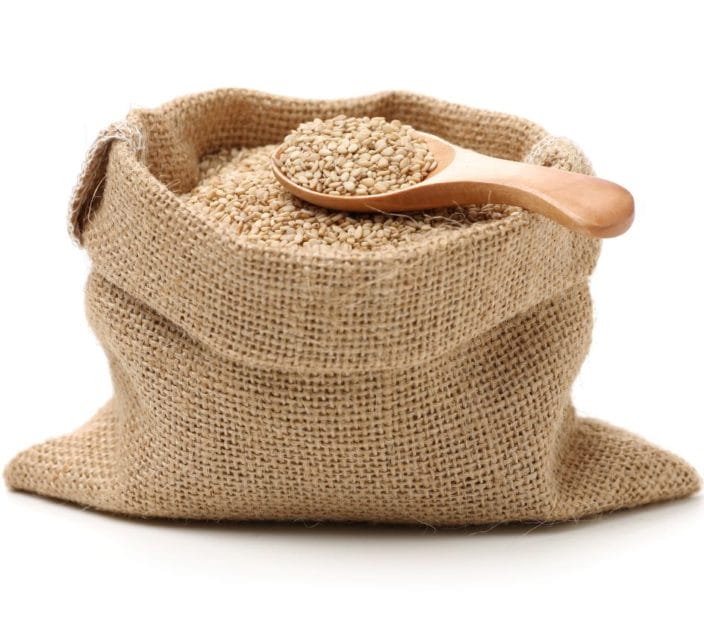 The Auvi-Q “talking” epinephrine auto-injector will relaunch across the United States in the first half of 2017, senior executives of the pharmaceutical company Kaléo announced in late October. “We are very excited about bringing it back, and can’t wait to get it into the hands of patients,” Spencer Williamson, Kaléo’s president and CEO told Allergic Living.
The Auvi-Q “talking” epinephrine auto-injector will relaunch across the United States in the first half of 2017, senior executives of the pharmaceutical company Kaléo announced in late October. “We are very excited about bringing it back, and can’t wait to get it into the hands of patients,” Spencer Williamson, Kaléo’s president and CEO told Allergic Living.
The announcement came just shy of one year after Sanofi US issued a voluntary recall of all Auvi-Q devices on Oct. 28, 2015, citing reports of the possibility of incorrect dosage delivery in 26 of the devices. (The identical Allerject device in Canada was simultaneously recalled.)
Sanofi later returned manufacturing, distribution and marketing rights to the Virginia-based Kaléo, which owns and invented the compact device that has novel voice-guided instructions for the user.
Allergic Living’s Editor Gwen Smith sits down with Spencer Williamson and Dr. Eric Edwards, Kaléo’s vice president of product strategy, to learn about the Auvi-Q’s relaunch, the steps to ensure the device’s reliability and the hot topic of epinephrine auto-injector pricing.
Q&A on Auvi-Q Relaunch
Gwen Smith: Thank you both for speaking to Allergic Living today with your news that you’re obviously excited about. Now when Kaléo took back the rights from Sanofi, you said the Auvi-Q would be back. What can you tell people first about what gives you the confidence that the Auvi-Q is ready to be back?
Spencer Williamson: It’s a great question, and we are very excited to announce the relaunch and the reintroduction of Auvi-Q into the first half of 2017. As you know Kaléo is the original inventor of Auvi-Q. So we’re thrilled to be in position to do this. And we have been working diligently to transition Auvi-Q back over to Kaléo.
Included in that was implementing an updated, innovative, 100 percent automated robotic precision production line that helps to ensure each device is built with the highest standards of safety, precision and quality. So we are excited about bringing it back – and can’t wait to get it into the hands of patients.
GS: You’re saying early in 2017, can you be more specific about when the auto-injector will be in pharmacies?
SW: The best counsel we can give at this point is first half of 2017 and we’re fully confident on bringing it back on that timeline, and doing it in a way that really benefits and best serves patients.
GS: The recall was over a suspected dose delivery issue. Obviously delivery of epinephrine is hugely important for somebody facing anaphylaxis. So while you’re speaking of a sophisticated robotics production and so forth, can you tell us more about how you’re ensuring the devices are reliable? And was there a problem?
Eric Edwards: So in 2015, the previous manufacturer of Auvi-Q voluntarily recalled the product – taking this step because a small number of devices were found to potentially have inaccurate dosage delivery. Which may have included the failure to deliver the drug.
Once Kaléo regained control of the product and resumed responsibility for manufacturing, we implemented our proven manufacturing and quality processes, including, as Spencer mentioned, creating an intelligent, high-tech 100 percent automated, robotic production line with over 100 quality checks on each Auvi-Q device to help ensure that consistent production process. We use specially calibrated sensors and vision inspection systems to ensure each component assembled into Auvi-Q is done so with precision.
Plus, for us it’s personal. I may have to use it on myself. And I have food-allergic children and Evan [his twin brother and co-inventor] does as well, and we’re going to have to potentially respond …. Hopefully, we never have to, but we build the Auvi-Q with that in mind, that we may have to administer it to one of our children one day. So we’re really focused on ensuring the highest level of quality and a flawless manufacturing process.
GS: As we know, people in the food allergy community are very concerned about epinephrine access. With this fall’s EpiPen pricing controversy, it became clear that epinephrine cost is a very big issue for an increasing number of Americans. How will Auvi-Q be priced?
SW: We understand that price is central to the conversation. And we saw the impact over the summer of the lack of options and how much of an issue this became for so many, many patients. We believe that patients should have options when it comes to epinephrine auto-injectors.
Further, we believe when a physician prescribes Auvi-Q, the patients should be able to obtain the product without insurance barriers and without high out-of-pocket costs. Patients should be able to have access to Auvi-Q at an affordable, low out-of-pocket cost.
GS: OK, but do you have pricing established at this point?
SW: We are working on the price right now and engaging with all of the stakeholders – including the insurance companies, the pharmacies, the pharmacy benefit managers or PBMs – and at the end of the day, what’s most important is the cost to the patient. As we work with the stakeholders, we’re working to implement a comprehensive access program for Auvi-Q. Our goal is that for every patient that is prescribed an epinephrine auto-injector, they can have access to Auvi-Q with a very low out-of pocket cost.
GS: So are you looking at a couponing type of arrangement such as we’ve seen from EpiPen or what are you speaking of?
SW: We’re working with all of the stakeholders on how best to structure that. A lot of that is still in the works.
GS: Now when Mylan was under fire over pricing, they suddenly came forward and said, ‘we’re also going to release a more affordable EpiPen generic auto-injector.’ Mylan’s CEO says it will be priced much more attractively. Will you be able to compete with that generic?
SW: You raise an important issue – options and pricing for patients. I can’t speak for what other companies are doing or why they’re doing it. What we’re doing is engaging with the stakeholders [insurers, PBMs etc.] that, as you well understand, play such an important role in what the ultimate price and cost is … when we bring Auvi-Q back to the market.
We’re in those discussions now. But what I can assure you is that we are going to solve this issue and put the patients first and ensure that every time a patient is prescribed an Auvi-Q, they will be able to gain access to it for low out-of-pocket prices.
GS: When Mylan and the FDA were called before the House Oversight and Government Reform Committee, the lawmakers were very concerned about the availability of competition in the epinephrine device arena. What impact will Auvi-Q’s return have on competition and on the consumer?
SW: Well, we think in this space that two things are really important. One is choice and the second is innovation. We are very excited about giving choice back to patients and to physicians. And we think the innovation that we have with Auvi-Q provides real value to patients. That’s what is so often overlooked in the epinephrine auto-injector space is the value of an innovative product in a life-threatening allergic emergency.
EE: We know and we built Auvi-Q with the life-threatening allergic community in mind; having that ability to respond during that allergic emergency is critical. We asked ourselves right at the beginning, years ago, what is the value of any epinephrine auto-injector if it is not: first, available and with you at the time of an allergic emergency, and second, able to be used correctly during that panic-stricken moment.
I’ve had anaphylaxis. Unfortunately, I’ve had to respond to my own child having an anaphylactic reaction and, even as a paramedic and as a doctor, that moment was terrifying. It’s with that in mind that Auvi-Q includes those industry-first features. It includes a length and the width of a credit card; the thickness of a small cell phone so that individuals can discreetly carry the product, and have it with them during that allergic emergency. It includes that voice-guided instruction system, similar to an automated external defibrillator [AED], that can assist in guiding even an untrained user through that panic-stricken moment, and it includes a retractable needle system.
GS: You have said the Auvi-Q won’t be available until the first half of 2017. Why let the news out now?
SW: We are very excited as you can imagine to announce the return of Auvi-Q and we have been working on the transition of Auvi-Q back to Kaléo and then working through the manufacturing updates to ensure we can bring a product at the highest standards of safety, precision and quality. We are now in a position that we are fully confident in our ability to bring back this innovative product in the first half of 2017.
EE: Just also add to that, we saw the impact over the summer of the lack of available options for the allergy community. That ability now for us to say: ‘Auvi-Q is returning, Auvi-Q is coming back, there will be another option available’ is huge. We believe strongly and we know a lot of the allergic community believes that patients deserve innovation and Auvi-Q was an innovative option.
GS: Will Auvi-Q two-pack sets have national availability across the United States?
SW: Yes. And it will be in a two-pack – with two active products and a trainer device.
GS: Now what about the Allerject in Canada – the same device by a different name. It was quite popular. Will it also be back?
SW: Right now we’re focusing on the re-introduction in the U.S. We’re evaluating alternatives for bringing it back to international markets, but right now our focus is on the U.S. I think it’s best to stay tuned and we’ll communicate when we’re in a position to do so. Right now, we really are very focused on bringing it back in the right way, getting it into the hands of patients in an affordable manner, in the U.S. market.
GS: One of the other questions that’s arisen lately is epinephrine shelf life. Can you say what the shelf life will be on the devices?
EE: We are definitely going to be providing more information on that when we make the product available in that first half of 2017.
SW: But let’s just make sure we’re clear on this. The shelf life of Auvi-Q is going to remain the same. Our goal is to have shelf life that is industry standard, and we’ll continue to have that when we bring it to the market. What we’re going to assure is that, when patients have access to Auvi-Q, that it has the appropriate shelf life that is customary in the industry and that will be typical for what the epinephrine products are.
GS: Eric, you and your brother first had the idea for designing this device when you were teenagers. Tell our readers a little bit more about the personal importance of getting the Auvi-Q back on the market.
EE: Yes, and thank you for asking. You can imagine a year ago just how devastating it was when not only Evan and I, but the entire Kaléo team learned that Auvi-Q learned that it was going through a voluntary recall. It impacted us very deeply. But now we have the product back as the original inventors and we could not be more thrilled. As a company committed to innovation and committed to patients, it is going to be a very exciting moment to be able to walk my family back into that CVS in that first half of 2017 and be able to have an Auvi-Q prescription filled again.
SW: One of the things we’re proud of at Kaléo, is that we are intentionally a very different company. We changed the name of our company to Kaléo because the Greek meaning of the word kaléo is to answer a calling or to have a purpose. And that’s really how we believe we run the business. So we feel ‘called’ to build innovative products for the treatment for life-threatening emergencies.
One of the most exciting moments at Kaléo was 27 days after Auvi-Q was launched in 2013, a mother posted on Facebook that her daughter had saved her own life with Auvi-Q. There’s not a person in our company who can’t tell you where they were, what they were doing, when we found out about that first life saved. So Kaléo is a very different company and while we’re proud of our 100 patents, while we’re proud of all the innovations and our product approvals, what we’re most proud of the reported lives that we’ve saved. That’s what really drives the company.
GS: On that note, we’ll look forward to hearing more about the launch timing, and I thank you for telling our audience about your big news.
[Both express their thanks.]







